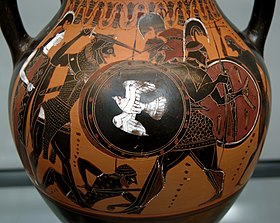
Back Swartfiguurstyl Afrikaans الفخار ذو الشكل الأسود Arabic Чорнафігурны вазапіс Byelorussian Ceràmica de figures negres Catalan Хура кӗлеткеллӗ ваза ӳнерӗ CV Sortfigurs-keramik Danish Schwarzfigurige Vasenmalerei German Μελανόμορφη αγγειογραφία Greek Cerámica de figuras negras Spanish Mustafiguuriline stiil Estonian

Black-figure pottery painting, also known as the black-figure style or black-figure ceramic (Ancient Greek: μελανόμορφα, romanized: melanómorpha), is one of the styles of painting on antique Greek vases. It was especially common between the 7th and 5th centuries BCE, although there are specimens dating in the 2nd century BCE. Stylistically it can be distinguished from the preceding orientalizing period and the subsequent red-figure pottery style.


Figures and ornaments were painted on the body of the vessel using shapes and colors reminiscent of silhouettes. Delicate contours were incised into the paint before firing, and details could be reinforced and highlighted with opaque colors, usually white and red. The principal centers for this style were initially the commercial hub Corinth, and later Athens. Other important production sites are known to have been in Laconia, Boeotia, eastern Greece, and Italy. Particularly in Italy individual styles developed which were at least in part intended for the Etruscan market. Greek black-figure vases were very popular with the Etruscans, as is evident from frequent imports. Greek artists created customized goods for the Etruscan market which differed in form and decor from their normal products. The Etruscans also developed their own black-figure ceramic industry oriented on Greek models.
Black-figure painting on vases was the first art style to give rise to a significant number of identifiable artists. Some are known by their true names, others only by the pragmatic names they were given in the scientific literature. Attica especially was the home of well-known artists. Some potters introduced a variety of innovations which frequently influenced the work of the painters; sometimes it was the painters who inspired the potters’ originality. Red- as well as black-figure vases are some of the most important sources of mythology and iconography, and sometimes also for researching day-to-day ancient Greek life. Since the 19th century CE at the latest, these vases have been the subject of intensive investigation.